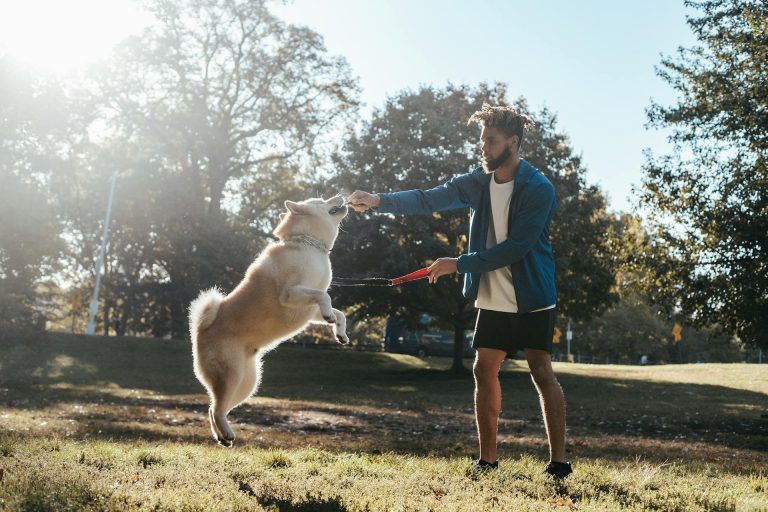If you have a dog whose tail tucks more often than it wags, you’re not alone. Many pups struggle with shyness, and traditional dog parks can feel like a nightmare for them.
When I first got my dog Milo, a Jack Russell terrier, we would often go to dog parks. And more often than not, we would see some shy dogs there that just didn’t have it in them. They would hide behind their owner’s legs and stay there.
Now, what many people might think is a great place for socialization, and helping your dog build confidence, it is not.
Shy dogs are a real thing, and taking them to the dog park with many dogs inside will not solve the issue, no matter how often you go there.
Understanding Canine Shyness
Many dogs do not thrive in chaotic dog parks. Let’s be honest, some dog breeds were not made for the dog park. For example, some apartment dogs like Shih Tzu. Their purpose is to cuddle with their pet parent, not go to the dog park.
There is nothing wrong with owning a shy dog. You should not be judgmental about it. And you should not try to put your dog in a situation where anxiety creeps in.
Dog parks are tough. There are many unpredictable dogs there and a lack of escape routes for your puppy. Here are some signs of canine shyness:
- Hiding and avoidance, seeking corners, hiding under furniture, trying to escape when in public
- Tucked tail, lowered ears, cowering posture, trembling, and other body language signs of fear
- Excessive vocalization, barking nervously or whining as a sign of stress, not aggression
- Stress signals like yawning, lip licking, averting the gaze
Why you should not go to a dog park?
You might think that dog parks are the best places for puppy socialization and building up confidence. They are not. Instead, dog parks might be overwhelming.
They are unpredictable, to say the least. Imagine plenty of unfamiliar dogs running off-leash, varying playstyles, potentially poor social skills, and everything in between. Now think how your shy dog might feel in such a situation.
There are no escape routes in dog parks. Your dog will feel trapped in an enclosed space with plenty of unknown dogs trying to sniff him/her.
And most importantly, there is too much noise, crowd, and commotion that can lead to sensory overload. Your sensitive dog will get even more anxious and will never want to step in a dog park again.
Why you should not push too hard?
What some dog owners are trying is to cure shyness with more socialization. But pushing too hard can only lead to erosion of trust. Forcing your shy dog into scary situations will damage the bond you two have. Instead of trusting you and feeling safe around you, your puppy might associate you with fear. And you do not want that.
Pushing too hard can lead to heightened anxiety. Instead of getting used to it, dogs might feel more anxious over time.
And last, but not least, there is always the potential for aggression. Imagine you feel cranky, and someone is poking you over and over again. Will you eventually react? Well, that can happen to your puppy as well.
A cornered, terrified dog might lash out in aggression as a last resort. This will only reinforce the misconception that shy dogs are also aggressive. But that is not the case.
What can you do?
In the last several years, the concept of private dog parks has been gaining popularity and noise. Remember, shy dogs are not disobedient or difficult on purpose. They do have a genuine fear response. It is your role as a pet parent to work with your puppy and improve its confidence. Here are some ways to improve your dog’s confidence.
- Train your dog to complete small tasks and gradually increase the difficulty to keep them challenged.
- Set your dog up for success by creating situations where they can win.
- Once your dog is confident at home, practice basic obedience on walks.
- Implement desensitization in your training by gradually exposing your dog to things they are afraid of.
Now, why are private parks great? Well, for one, you can go there, and work on some training, without any distractions. You can build a foundation, and from there, continue building your dog’s confidence.
With private parks, be it an agility park, a simple enclosed park, or a pool, your dog can sniff and explore freely with minimal pressure. Add in some positive reinforcement awards, and you can reward brave moments.
Final words
Remember, not every dog is a dog park dog. Imagine you have a working dog breed that is also shy, for example, a Doberman. Or think of it this way, no matter how socialized and trained your Doberman is, people might be afraid of it in the dog park.
A controlled environment allows your dog to set the pace of interactions and reduce anxiety. No unknown dogs are rushing in. And there is plenty of space to feel safe.






